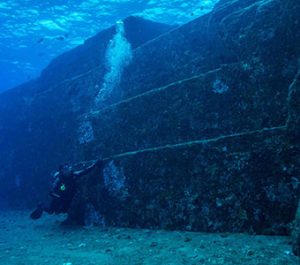From the amazing archaeological discoveries which are made daily worldwide, the ones that almost surely capture popular imagination are the ones that are discovered beneath the ocean. The inquisitiveness and apprehension about what lies beneath the surface in the dark depths of the ocean, the thought that a new world may lie on the ocean floor out of the range of people’s reach is something that has always fascinated people the world over.
With great advances in the technology of the field of marine archaeology, this new world is being brought to the notice of the world above, as more and more discoveries are made. Five remarkable marine discoveries that have captured our imagination are listed below:
- Artifacts retrieved from the site of the first-ever ancient naval battle
In November 2013, marine archaeologists revealed that they had recovered a trove of artifacts off the coast of Sicily in Italy from the site of the first ancient naval battle ever discovered. The artifacts included battering rams, helmets, armor, and weapons which dated back 2,000 years. The artifacts were the remains of the Battle of the Egadi Islands which was the last battle of the First Punic War. It took place in 241 BC. The Punic Wars were a series of clashes that took place between the Roman Republic and the city-state of Carthage in North Africa. The conflict resulted in three wars and ultimately led to the destruction of the city of Carthage by the Romans and Carthage becoming a Roman province.
During the Battle of the Egadi Islands, the Romans fought the Carthaginians in a battle that resulted from more than 20 years of fighting as the Romans tried to gain a foothold in the Mediterranean Sea. Though the Carthaginians were stronger on the water, the Romans were waiting for them and trapped the Carthaginians blocking off their escape route in a sudden attack. Around 50 Carthaginian ships were sunk, and 10,000 men were killed. The Roman victory resulted in Rome forming the Roman Empire which included areas on three continents and made Rome the mightiest power in the Mediterranean and the ancient world. The invaluable cache of artifacts that were recovered had lain on the ocean floor at a depth of 100 meters for more than two thousand years
- 2,000-year-old Roman medicinal pill found intact in submerged ship
In June 2013, Italian scientists chemically analyzed some ancient Roman medicine pills which had been discovered in the Relitto del Pozzino, a 2000-year-old submerged ship that had sunk off the coast of the Italian region of Tuscany. The test revealed substances which the ancient Romans made use of as medicine. The Roman-era shipwreck was found near the remains of Populonia, an Etruscan city that had been a key port along the sea routes linking the West and the East over the Mediterranean Sea at the time when the ship had gone down. The Relitto del Pozzino was unearthed by the authorities in Tuscany during the 1980s and 1990s. The wreck revealed a variety of cargo including lamps from Asia minor, Syrian-Palestinian glass bowls, bronze jugs, ceramic vessels for carrying wine, and, interestingly, the remains of a medical chest containing a surgery hook, a mortar, 136 wooden drug vials, and many circular tin vessels, one of which contained five-round medical tablets. The tin vessels had been completely sealed for over two millennia. This kept the tablets dry and intact, giving a wonderful chance to find what ingredients were contained within them. The research showed that the pills contained several zinc admixtures, iron oxide, starch, beeswax, pine resin, and other materials derived from plants. Based on their shape and composition, it has been suggested by the researchers that they were used as a type of eye medicine.
- Stunning find of 3200-year-old boat wreck in Croatia
In March 2014, French marine archaeologist and researcher Giulia Boetto discovered a boat wreck in Zambratija Cove, Croatia, which was dated to 1,200 BC. This unique and rare and at the same time amazing finding was a Bronze Age-era sewn boat, a kind of wooden boat that is sewn together using ropes, roots, or branches of willow trees. The boat wreck was first seen by fishermen in 2008, only 600 meters from the beach and just two meters below the surface of the water. But they had believed it to be a recent wreck. The boat measured 7 meters in length and 2.5 meters in breadth. Sewn boats were a technique of shipbuilding that was practiced in the Adriatic Sea until the Roman era.
The remains of the boat discovered were surprisingly well-preserved despite its age, with the stitching still noticeable in some areas and the frame being largely undamaged. The various types of wood used to construct the boat were identified as elm, alder, and fir. Tree ring dating was conducted to provide the date the tree was cut. The scientists also hoped to finalize a 3D model of the boat and, eventually, reconstruct it completely.

- Discovery of 11,000-year-old relics in Sweden
In 2014, Swedish divers made an exclusive and unusual discovery in the Baltic Sea. These were Stone Age artifacts that had been left by Swedish nomads 11,000 years ago. Researchers uncovered a number of these remnants which had been left behind by Swedes in the Stone Age. These objects had been preserved because of the lack of oxygen and the profusion of the gyttja sediment, which is considered to be rich in organic matter.
It is very unusual and rare to find objects from the Stone Age in such an unspoiled state. They were found buried 16 meters below the surface of the sea. The divers also uncovered wood, flintstones, horns of animals, and ropes. The most remarkable items found included a harpoon carving made from animal bone, and the bones of an ancient animal called aurochs, which is the ancestor of domestic cattle, and which became extinct in Europe in the early 1600s. However, the remains do not come from a great city or even a village because the people in the Stone Age era were nomadic. Archaeologists are specifically interested to see whether there was also an ancient burial site in the region.
- Discovery of strange 10,000-year-old underwater ruins in Japan
On the southern coast of Yonaguni, near the coast of Okinawa, Japan, are underwater ruins that are estimated to be nearly 10,000 years old. Though the origin of the site is disputed, many researchers have argued that the ruins are man-made, while many others insist that it was created due to natural phenomena. This awe-inspiring site was discovered in 1995 by a diver who had wandered too far off the coast of the island of Okinawa and was stunned when he came upon the sunken series of monolithic blocks which looked as if they had been terraced into the side of a mountain. The location has great stone blocks which fit with each other perfectly, and have joints at right angles. There are also carvings and structures which appear to be stairs, cobblestone streets, crossroads, and squares. Despite the unusual features displayed at Yonaguni, there remain some researchers, who have studied the structure and who still believe that they were formed naturally as a result of the movement of tectonic plates and undersea earthquakes.













